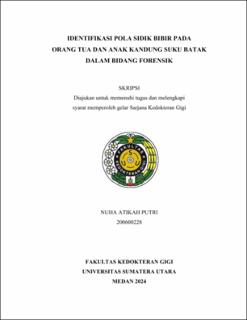| dc.description.abstract | Lip prints are one of identification in forensic odontology. One of the factors
involved in lip print patterns is heredity. This is explained by Mendel's Law, where
children inherit genes from their parents. Aim: to determine the distribution, frequency
of dominant lip print patterns for each quadrant, dominance, and similarity of lip print
patterns between fathers, mothers, male biological children and female biological
children of the Batak tribe based on Suzuki and Tsuchihashi classification. Methods:
observational analysis with cross-sectional design. Lip prints were taken using the
lipstick method from 66 samples consisting of 22 fathers, 22 mothers, 11 male
biological children and 11 female biological children. The lip prints were divided into
four quadrants, the lip print patterns were observed based on Suzuki and Tsuchihashi
classification. Results: the dominant lip print pattern of quadrant I in the subjects of
father, mother, male biological children and female biological children was mostly
Type II. The dominant lip print pattern of quadrant II in the subjects of fathers, mothers,
male biological children is mostly Type II, while in the subjects of female biological
children is mostly Type II, Type III and Type IV. The dominant lip print pattern of
quadrant III in subjects of fathers and mothers is mostly Type III, while in subjects of
male biological children and female biological children is mostly Type II. The
dominant lip print pattern of quadrant IV in the subjects of fathers, mothers, male
biological children and female biological children is mostly Type II. The dominant lip
print pattern in the subjects of fathers, mothers, male biological children and female
biological children is mostly Type II. There is a significant similarity in the lip print
patterns of fathers and mothers with male biological children in quadrant IV, while the
other quadrants do not show statistically significant similarities. There is no significant
similarity in lip print patterns between fathers and mothers with female biological
children. Conclusion: there are similarities in lip print patterns between parents and
their children, but they are not absolute and still have different variations. | en_US |


